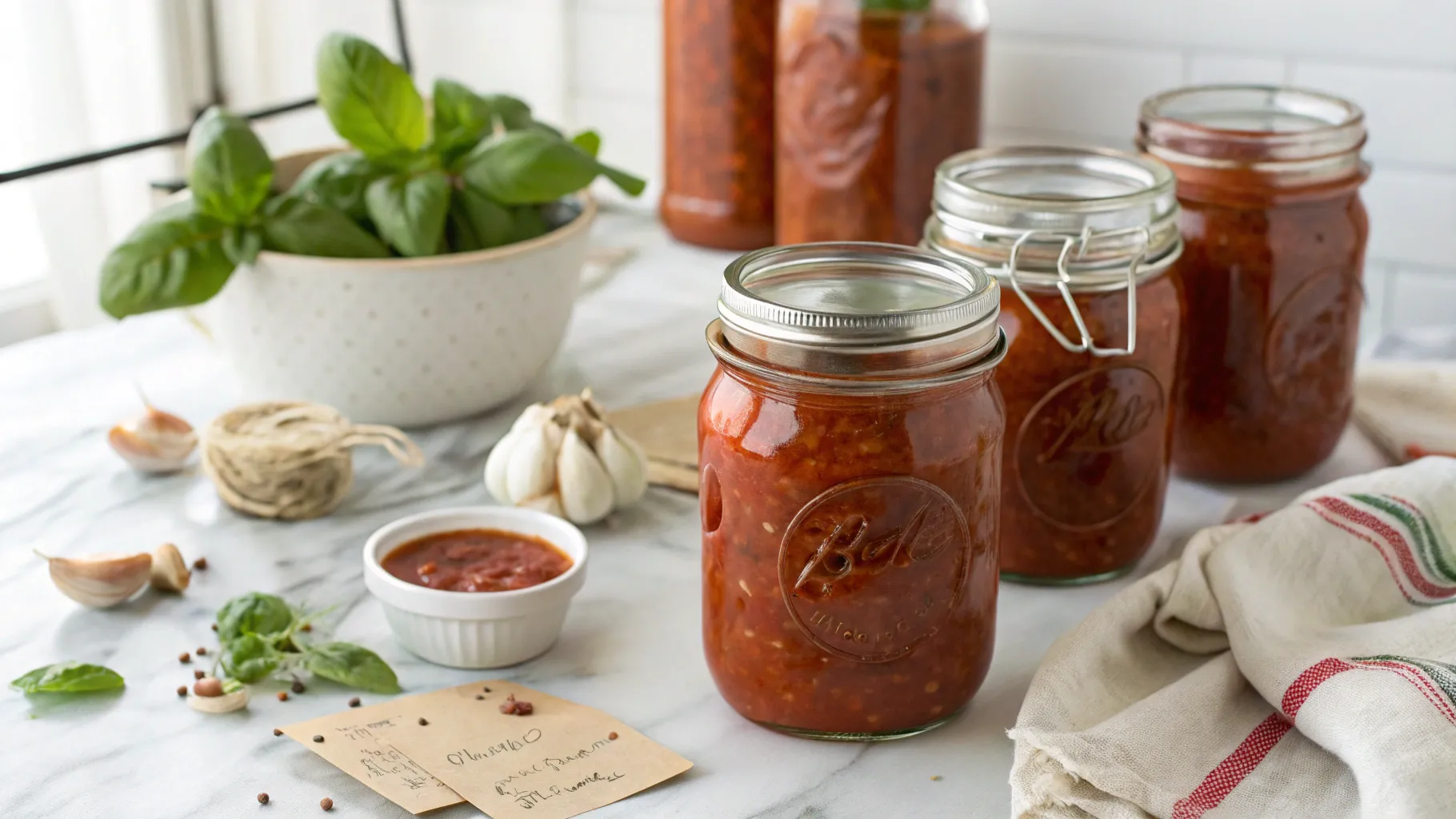When it comes to essential sauces in Italian cooking, Marinara Sauce reigns supreme. This tomato-based classic is the heart of countless dishes, from pasta and pizza to meatballs and even eggplant.
But don’t be fooled by its simplicity. A great marinara starts with quality ingredients: ripe tomatoes, garlic, olive oil, and herbs, slow-simmered to perfection. For an even more detailed walkthrough, you can follow our authentic marinara sauce recipe, designed for home cooks who want flavor without fuss.
Looking for inspiration on how to use it? Spoon it over classic baked spaghetti, layer it into eggplant parmesan pasta, or toss it with green garlicky pesto pasta for an herbaceous twist.
Even if you’re serving it on the side, a crusty slice of our sourdough baguettes makes the perfect companion. And if you’re just starting your culinary journey, our beginner’s guide to spices will help you master the subtle art of seasoning, vital for any great marinara.
Whether you’re keeping it traditional or putting your own spin on it, marinara sauce is a delicious reminder that simplicity, when done right, is anything but boring.
A Brief History of Marinara Sauce
The term “marinara” comes from the Italian word for “sailor.” It’s believed that the sauce originated in the Naples region of Southern Italy during the 16th century, created by cooks aboard merchant ships due to the simplicity and shelf-stability of its ingredients.
Without meat, cream, or wine, marinara sauce is humble, fast-cooking, and deeply rooted in Italian food culture. Over time, it evolved into a cornerstone of Italian-American cooking, loved for its adaptability and comforting flavor.
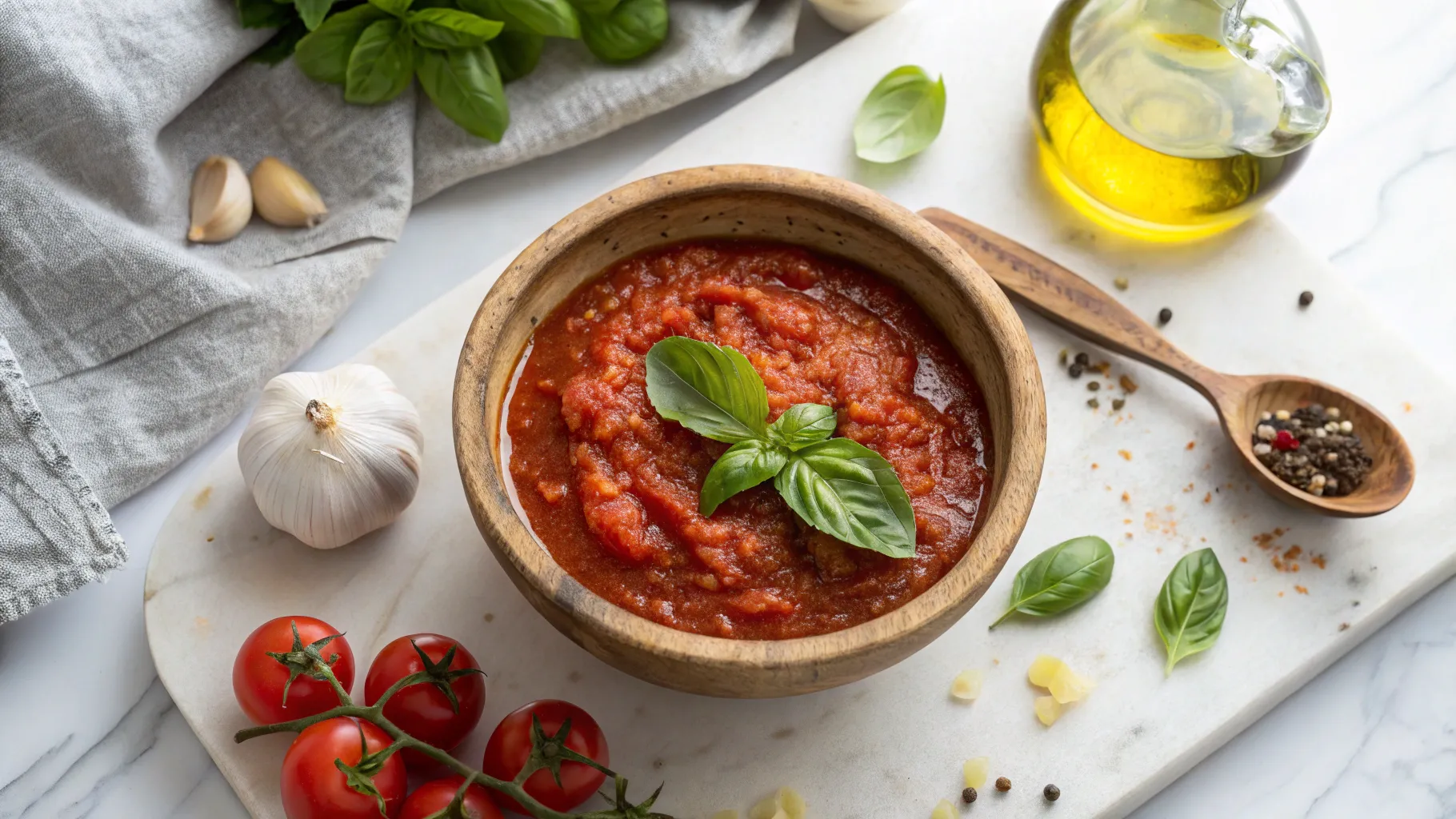
Step-by-Step Guide: How to Make Authentic Marinara Sauce
This process yields about 3–4 cups of sauce and takes under 45 minutes. Here’s how to make it:
Ingredients:
- 2 tbsp olive oil
- 3 cloves garlic, thinly sliced
- 1 small onion, finely chopped (optional)
- 1 can (28 oz) San Marzano tomatoes
- ½ tsp sea salt
- Handful of fresh basil leaves
- Pinch of black pepper
- Optional: 1 bay leaf
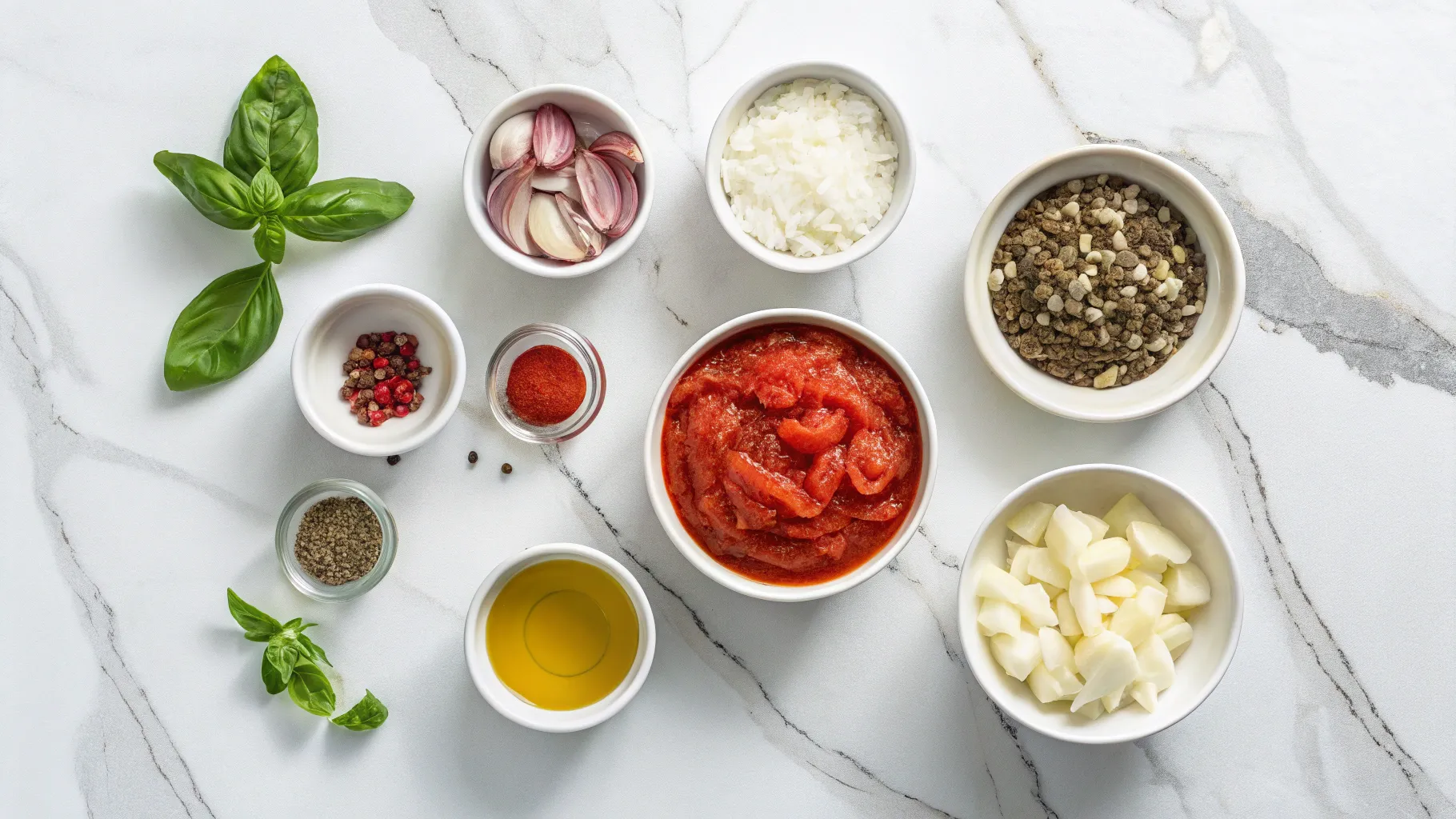
Instructions:
- Heat the oil in a saucepan over medium heat. Add the garlic (and onion if using), and sauté until fragrant but not browned, about 2–3 minutes.
- Crush the tomatoes by hand or use an immersion blender for a smoother texture.
- Add the tomatoes, salt, black pepper, and bay leaf to the pan. Stir to combine.
- Simmer gently over low heat for 25–30 minutes, stirring occasionally until thickened.
- Add basil during the last 5 minutes of cooking. Remove bay leaf before serving.
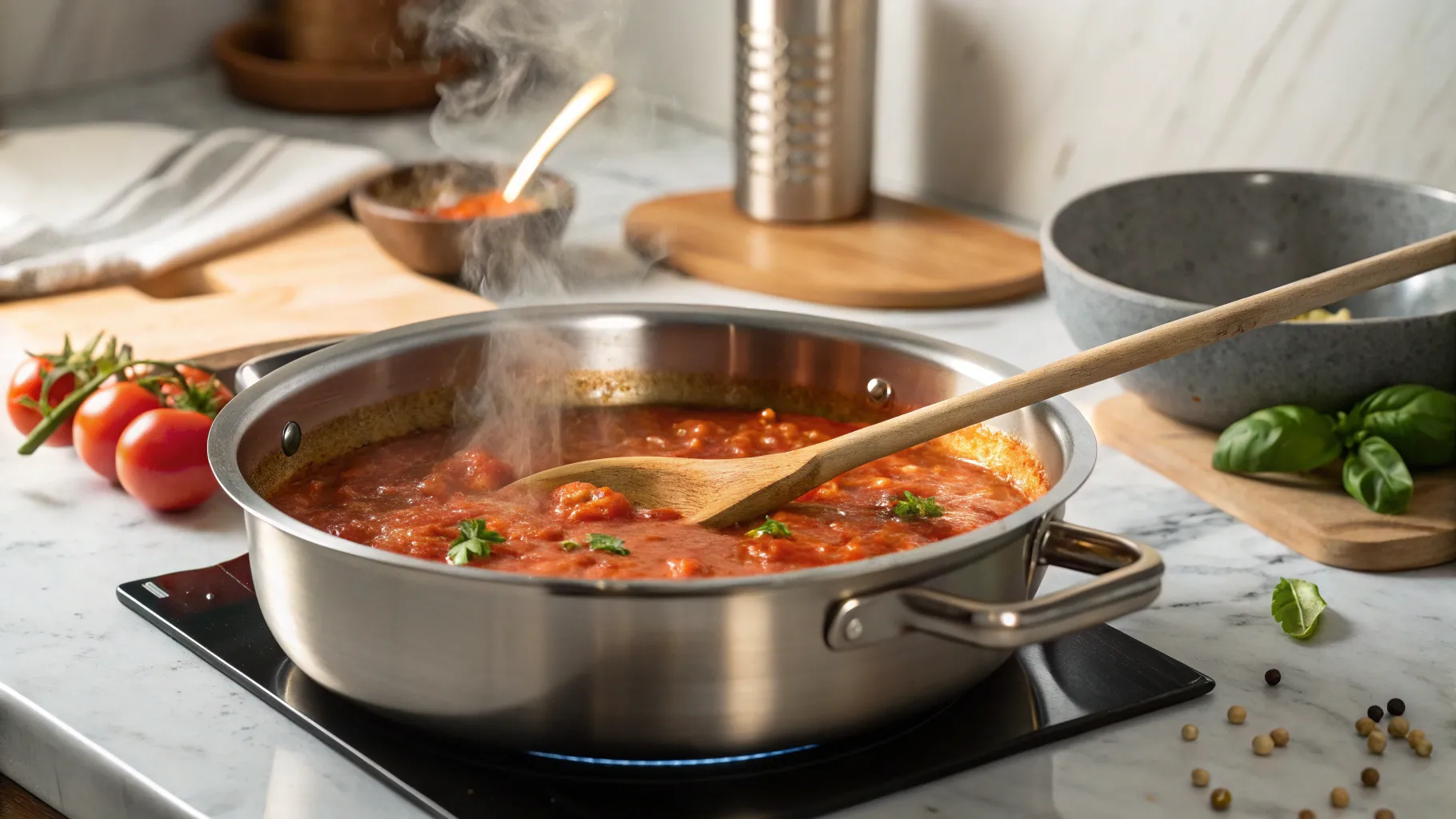
Fresh vs. Canned Tomatoes: What’s Best for Marinara Sauce?
When it comes to making the perfect Marinara Sauce, one of the first decisions you’ll face is whether to use fresh or canned tomatoes. Both options can yield a flavorful, satisfying result, but they each have unique pros, prep steps, and flavor profiles that affect your final sauce.
Let’s break it down so you can decide what works best for your kitchen, your season, and your schedule.
1. Canned Tomatoes: A Pantry Staple with Big Flavor
If you’re aiming for convenience and consistency, canned tomatoes are your best friend. In particular, San Marzano tomatoes, grown in the volcanic soil of Southern Italy, are widely regarded as the gold standard for Marinara Sauce.
Here’s why canned tomatoes are a top choice:
- Sweet, rich flavor with natural low acidity
- Soft texture, easy to break down
- Available year-round and ready to use
- No blanching or peeling required
- Ideal for quick, weeknight sauces
💡 Pro tip: Look for canned tomatoes labeled “whole peeled,” preferably with no added sugars or citric acid.
2. Fresh Tomatoes: Bright and Summery (When in Season)
On the other hand, if you have access to ripe, in-season tomatoes, especially heirloom or plum varieties, making sauce from scratch can elevate your marinara to a new level of freshness.
However, there are a few extra steps involved to get that restaurant-quality texture and flavor:
Prep Tips for Using Fresh Tomatoes:
- Peel them: Score the skins, blanch in boiling water for 30 seconds, then transfer to an ice bath. The skins will slide off easily.
- Remove the seeds: This prevents bitterness and excess water. Cut the tomatoes in half and scoop them out.
- Simmer longer: Fresh tomatoes often contain more water than canned, so allow extra time to reduce the sauce and develop a thicker consistency.
💡 Pro tip: Avoid underripe or overly acidic varieties, which can result in a watery or sharp-tasting sauce.
So, Which Should You Use?
The answer really depends on your priorities:
- For speed and convenience: Go with high-quality canned tomatoes.
- For peak-season flavor and full control: Use fresh, ripe tomatoes, especially when they’re abundant at the farmers’ market or in your garden.
Either way, focusing on the quality of your tomatoes, not just their form, is the key to a flavorful, balanced marinara.
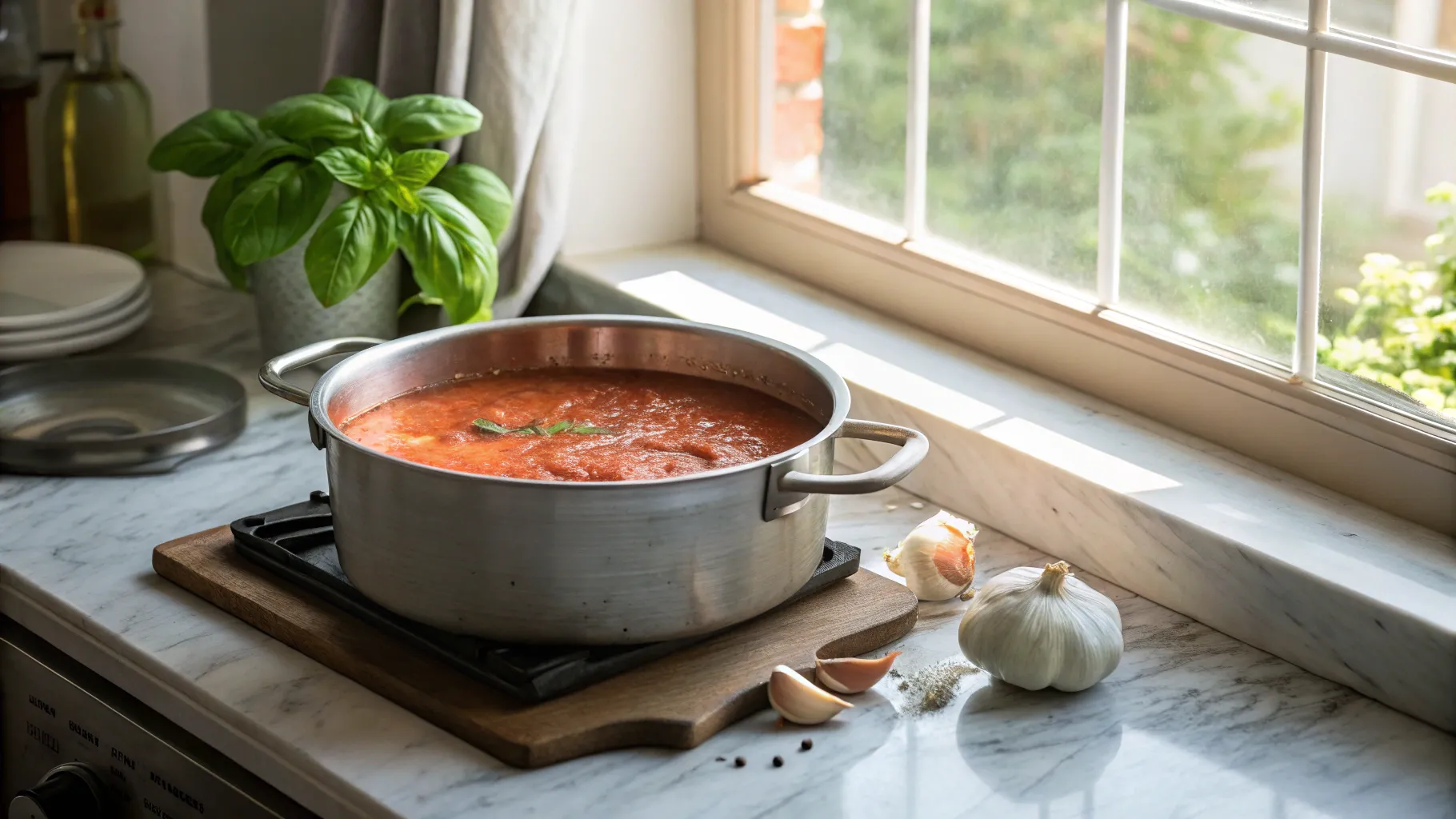
Common Mistakes to Avoid
Even with its simplicity, marinara sauce can go wrong if you’re not careful. Here are some key mistakes to dodge:
- Overcooking garlic – burns easily and becomes bitter
- Skipping the simmer – leads to watery, bland sauce
- Using too much oil – overwhelms the light tomato flavor
- Adding wine or meat – takes it away from its traditional, clean profile
Marinara Sauce Variations and Regional Twists
While traditional Marinara Sauce is known for its minimalism and elegance, that doesn’t mean it lacks flexibility. In fact, one of the reasons marinara has remained a kitchen staple for centuries is because it’s so easy to adapt, whether you’re adding a bit of spice, layering in herbs, or adjusting the texture to suit your preferences.
From regional Italian adaptations to modern spins in American kitchens, these marinara variations showcase just how versatile this humble sauce can be without ever losing its essence.
Let’s explore some of the most beloved ways to switch things up.
1. Spicy Marinara (Arrabbiata-Style Kick)
If you like a little heat, transforming your marinara into a spicy sauce is as simple as adding a few pinches of crushed red pepper flakes. Known in some parts of Italy as “arrabbiata”, which literally means “angry”, this fiery twist gives your sauce a bold edge without complicating the recipe.
To make it:
- Add ½ to 1 tsp of red pepper flakes while sautéing the garlic.
- Let it simmer with the sauce to distribute heat evenly.
- Serve with robust pastas like penne, or as a spicy dip for crusty bread.
💡 Pro tip: Perfect for those who love bold, zesty flavors.
2. Herb-Heavy Marinara (Mediterranean Vibes)
If you’re craving something more aromatic, try dialing up the herbaceousness of your marinara. Traditionally, marinara uses just a touch of fresh basil, but you can easily expand your flavor base by adding:
- Oregano for earthiness
- Thyme for warmth
- Flat-leaf parsley for brightness
- Bay leaf for a subtle bitter depth (remove before serving)
Add dried herbs at the beginning of the simmering process so they can infuse deeply into the sauce. Fresh herbs should be added toward the end to preserve their flavor and color.
💡 Pro tip: This version pairs beautifully with roasted vegetables or eggplant parmesan.
3. Chunky Rustic Style (Nonna’s Kitchen Feel)
In some regions of Italy, marinara is left intentionally unblended, creating a hearty, textured sauce that feels more rustic and homemade. This style works especially well when using fresh tomatoes or when you want to showcase the integrity of each ingredient.
To achieve it:
- Hand-crush your tomatoes instead of puréeing.
- Skip the immersion blender.
- Simmer until thick but still visibly chunky.
💡 Pro tip: Ideal for thick pasta like rigatoni, or spooned over grilled polenta.
4. Smooth Marinara (Silky and Elegant)
On the flip side, some prefer a velvety-smooth marinara with no chunks at all. This version is especially popular in restaurant-style dishes or as a pizza base, where a uniform texture allows for even spreading and baking.
How to get that silky finish:
- Blend your tomatoes before adding to the pan, or
- Use an immersion blender after simmering the sauce.
- Strain through a mesh sieve for an extra-fine result (optional).
💡 Pro tip: Works beautifully with meatballs, stuffed pasta, or refined dinner presentations.
A Sauce That Adapts to You
The beauty of Marinara Sauce lies in its simplicity, but also in its ability to reflect your own tastes, culture, or dietary needs. Whether you go for bold and spicy, rich in herbs, chunky and rustic, or smooth and silky, these variations allow you to personalize your sauce without compromising its Italian soul.
Start with the foundation, and let your taste buds lead the way.
How to Use Marinara Sauce
This sauce isn’t just for spaghetti, its uses are nearly endless. Here are our favorite ways to enjoy it:
- Tossed with pasta (spaghetti, penne, gnocchi)
- Layered in baked dishes (lasagna, stuffed shells)
- As pizza sauce (base layer for Neapolitan-style pizza)
- As a dip for breadsticks, mozzarella sticks, or arancini
- Poured over roasted veggies or grilled eggplant
- With chickpea patties or veggie meatballs for a plant-based twist
💡 Pro tip: A thin layer of marinara also makes a great base for flatbreads and focaccia.
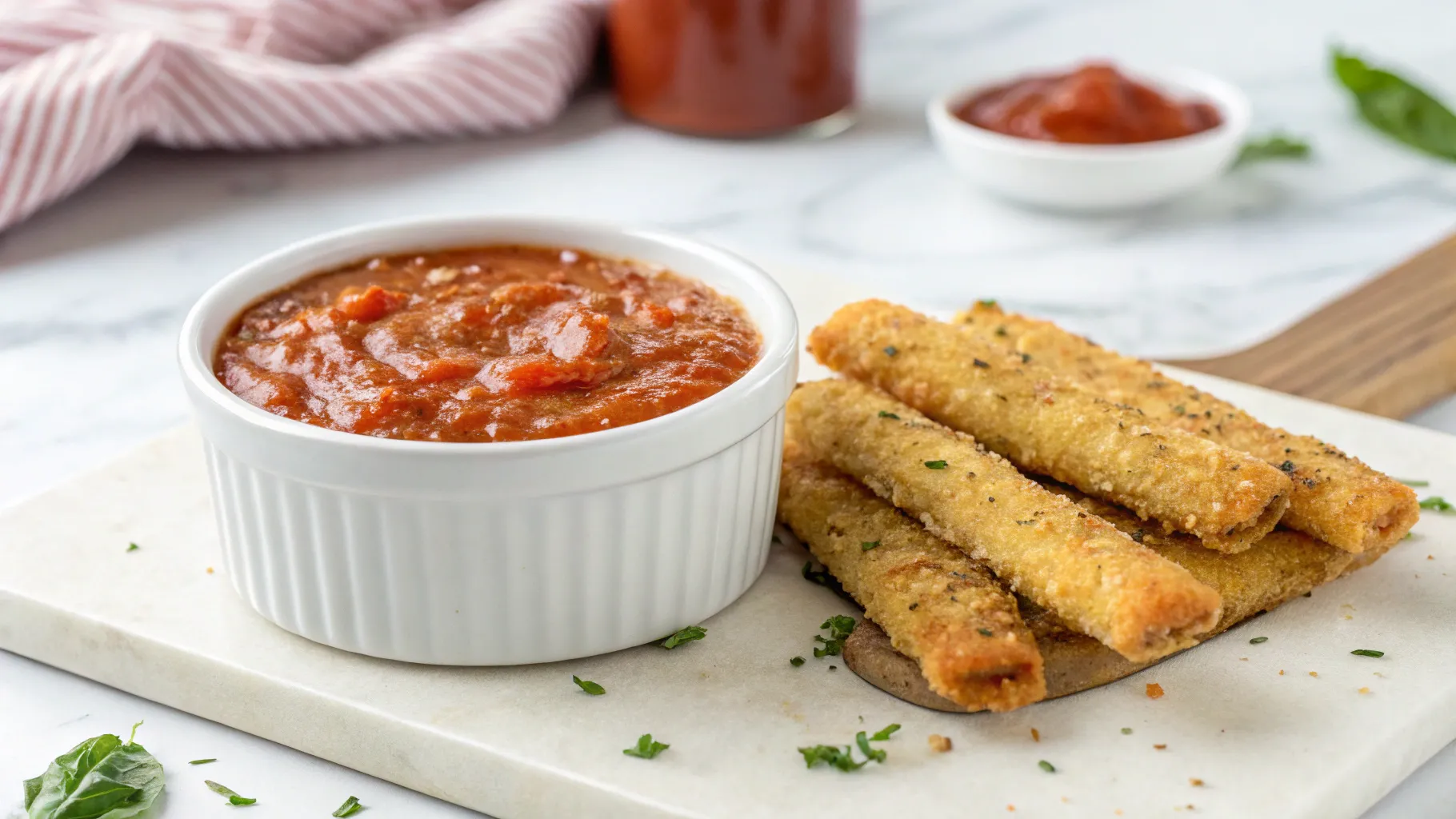
Make-Ahead and Storage Tips
Marinara Sauce is ideal for batch cooking. Here’s how to keep it fresh:
- Fridge: Store in airtight container for up to 1 week
- Freezer: Freeze in 1–2 cup portions for up to 3 months
- Reheat: Simmer gently on stove; add a splash of water if needed
Use silicone trays or freezer bags for easy stacking and labeling.
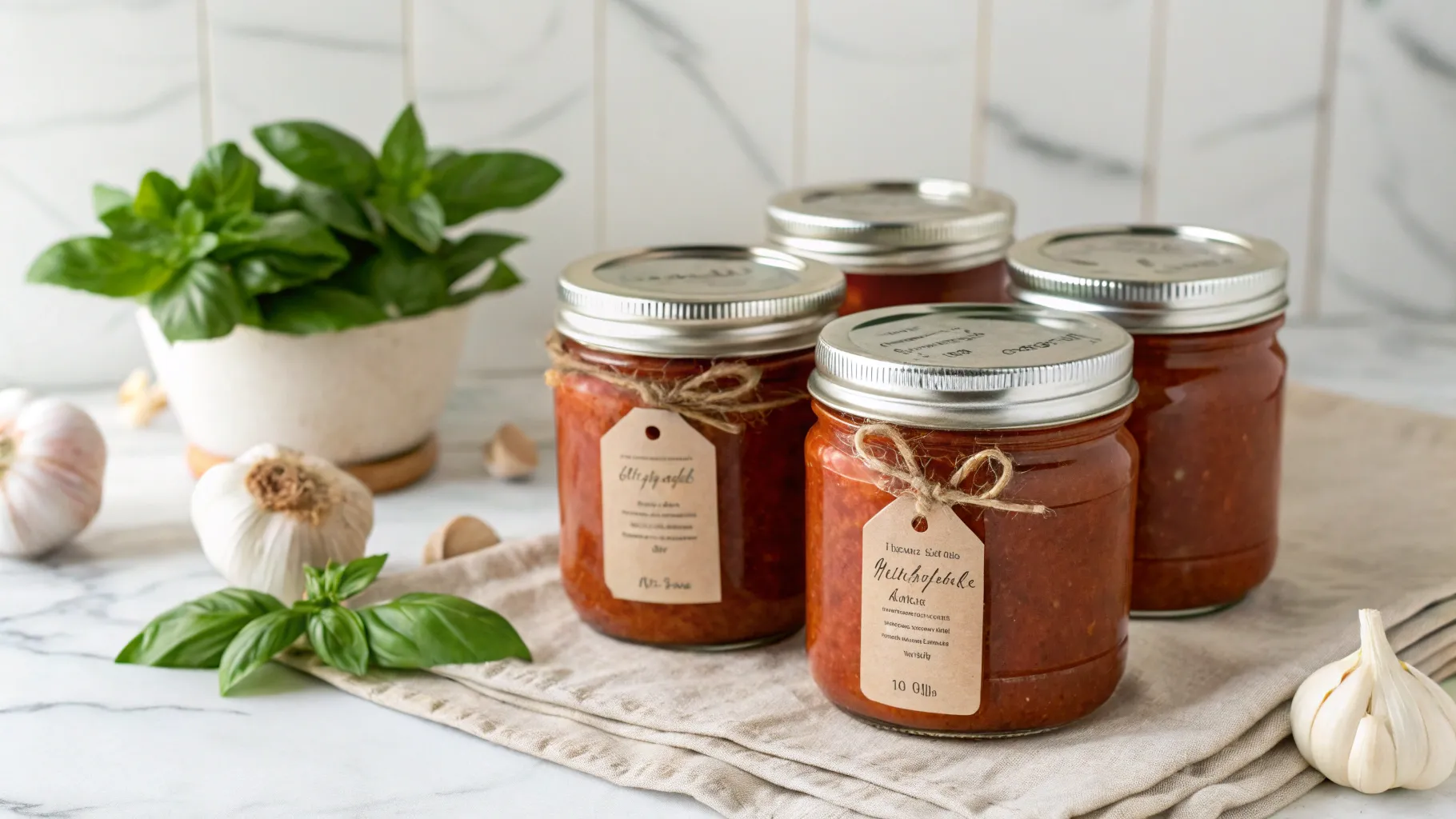
Nutritional Benefits of Marinara Sauce
Beyond taste, marinara is actually quite nutritious. Let’s break it down:
- Tomatoes: High in lycopene, vitamin C, and potassium
- Garlic: Natural antibacterial and anti-inflammatory
- Olive oil: Source of heart-healthy monounsaturated fats
- No added sugar or preservatives when homemade
This makes it a great choice for those following low-fat, vegan, or Mediterranean diets.
Marinara vs. Other Sauces: What’s the Difference?
It’s easy to confuse marinara with other tomato-based sauces. Here’s how they differ:
- Tomato Sauce: Usually simmered longer, thicker, may include meat or stock
- Pomodoro Sauce: Smoother, often blended, and typically uses fresh tomatoes
- Arrabbiata Sauce: Marinara with added chili flakes for heat
Dietary Benefits and Special Considerations
If you’re cooking for people with dietary restrictions, marinara sauce is a safe and adaptable option:
- Naturally vegan & vegetarian
- Gluten-free
- Low in fat and can be sodium-adjusted to preference
Just make sure to double-check your canned tomato labels for additives or animal-derived thickeners.
Marinara Sauce FAQ
What’s the difference between marinara and tomato sauce?
Tomato sauce is cooked longer, often includes more ingredients like broth or meat. Marinara is quicker, simpler, and lighter.
Q1: Can I freeze marinara sauce?
Yes! It freezes well in airtight containers for up to 3 months.
Q2: Is marinara sauce healthy?
Absolutely. It’s low in fat and rich in nutrients, especially when made from scratch.
Q3: How long does it last in the fridge?
Up to 1 week when sealed properly in an airtight container.
Q4: Can I use marinara on pizza?
Yes! Just simmer a bit longer to thicken slightly for spreadability.
Q5: What can I use instead of San Marzano tomatoes?
Use quality canned whole peeled tomatoes. Look for “Italian-style” with no added sugar or preservatives.
Final Thoughts
At its heart, marinara sauce is proof that the best things in the kitchen are often the simplest. With just a few ingredients and a bit of time, you can create a sauce that’s rich in flavor, light in ingredients, and endlessly useful.
Whether you’re serving it with pasta, storing it for later, or gifting it in jars, this classic Italian staple will never go out of style.
💡 Enjoyed this recipe?
Follow us for daily kitchen tips and tasty inspiration!
📌 Pinterest | 📘 Facebook | 📸 Instagram
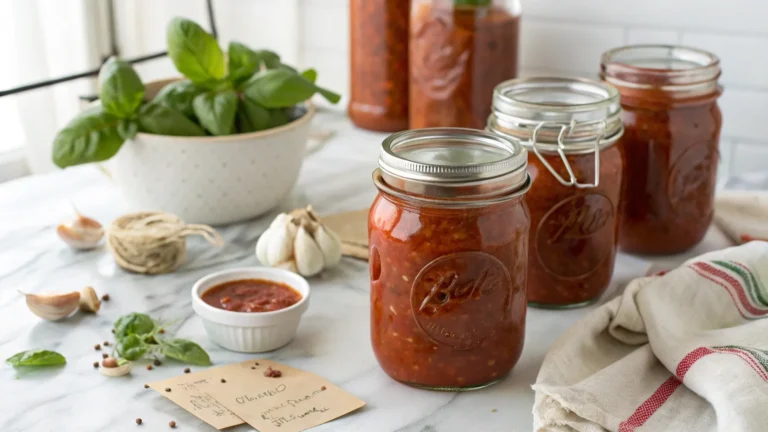
Marinara Sauce: A Classic Italian Staple Made Simple
This classic Italian Marinara Sauce is simple, fresh, and bursting with flavor. Made with just a few ingredients, it’s perfect for pasta, pizza, or dipping.
- Total Time: 35 minutes
- Yield: Makes ~3–4 cups (serves 4–6)
Ingredients
- 2 tbsp extra virgin olive oil
- 3 cloves garlic, thinly sliced
- 1 small onion, finely chopped (optional)
- 1 can (28 oz) whole peeled San Marzano tomatoes
- ½ tsp sea salt
- Pinch of black pepper
- Handful of fresh basil leaves
- 1 bay leaf (optional)
Instructions
- Heat olive oil in a saucepan over medium heat.
- Sauté garlic (and onion, if using) until fragrant but not browned.
- Add crushed tomatoes, salt, pepper, and bay leaf. Stir well.
- Simmer uncovered for 25–30 minutes, stirring occasionally.
- Add fresh basil during the last 5 minutes. Remove bay leaf.
- Use immediately or store for later.
- Prep Time: 5 minutes
- Cook Time: 30 minutes
- Category: Sauce, Condiment, Vegan Recipe
- Method: Stovetop simmer
- Cuisine: Italian
- Diet: Vegan
Keywords: Marinara Sauce, homemade red sauce, Italian tomato sauce, vegan pasta sauce, tomato basil sauce, pizza sauce

